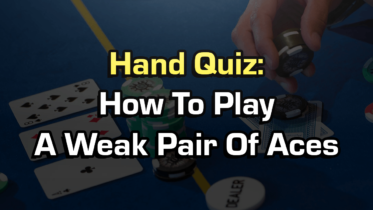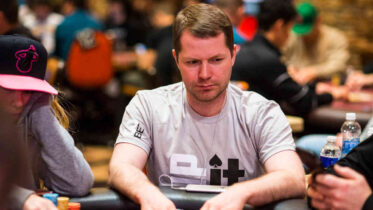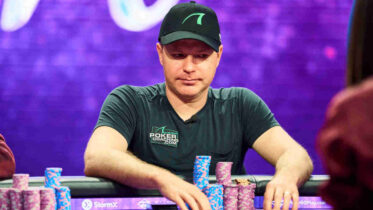A pair of aces is usually a strong hand at any poker table, but sometimes it can get tricky when you lack a good kicker. When you face a tough bet with only a 2 behind your ace, it can certainly feel like the walls are closing in.
Scenario: You are eight-handed in a $1,000 buy-in live tournament. You have 15,000 chips with the blinds at 75-150 when a tight, aggressive player UTG+1 raises to 350. It folds to you in the cutoff with A♣-2♣.

Considering A Raise
If you think you have a lot of preflop or post-flop fold equity (meaning you expect your opponent to fold to sheer aggression too often), three-betting is a strong play. However, given your opponent is tight and aggressive, indicating their range should be decently strong, it is best to call and try to flop well.
Action: You elect to call and the big blind calls as well. The flop comes A♠-Q♥-3♣. Your opponents check to you.
Playing The Flop
The Pot: 1,025
The Board: A♠-Q♥-3♣
Effective Stack: 97 Big Blinds Effective
Proceeding With Flopped Top Pair
It is important to figure out if the initial raiser has many aces in their range. If they do, you should definitely check behind. If they do not, it is fine to make a small or medium bet. You do not want to bet too large because then most worse hands except a queen will fold, resulting in you often putting in a decent amount of money poorly.
Checking behind is also nice because you will never face a check-raise. In general, when you have a decently strong hand that cannot confidently continue against a check-raise, you should often check behind (assuming your opponents are capable of check-raising).
Action: You check and the turn card is the J♠. The big blind checks and the UTG+1 player bets 500.
Playing The Turn
The Pot: 1,525
The Board: A♠-Q♥-3♣-J♠
Effective Stack: 97 Big Blinds Effective
Facing A Bet With A Paired Ace
There is no point in raising because your opponent will usually call all better hands and fold most worse ones. Once the UTG+1 player bets, it is easy for them to have a better hand, like K-10, A-J, and Q-J. However, they could also be betting K-Q, K-J, or Q-10, which you beat, as well as sporadic bluffs.
Usually, when players bet small on the turn, they are holding a wide range of marginal made hands, many of which you beat. Calling is the only play that makes sense.
Action: You call and the big blind folds. The river is the 7♠ and your opponent checks.
Playing The River
The Pot: 2,025
The Board: A♠-Q♥-3♣-J♠-7♠
Effective Stack: 94 Big Blinds Effective
Extracting Value On The River
You now have the option to value bet or check behind. It is reasonable for your opponent to have some better A-x, but they may play almost all of them differently earlier in the hand, usually by betting the flop. Most likely, your opponent has a queen or jack.
Unless your opponent is either overly tricky such that they will have a lot of traps or overly tight such that they will fold a queen to a river bet, you should bet for value. Do not bet using a large size because that will often result in most opponents folding their Q-x and J-x. Bet using a small size of roughly half pot in order to extract a call.
Conclusion: You bet 1,200 and your opponent calls with Q♦-10♦. Good bet!
Want to check out the hundreds of interactive hand quizzes found on PokerCoaching.com? Check them out here.




